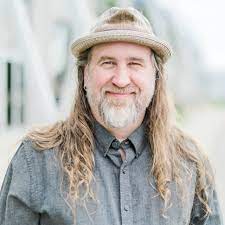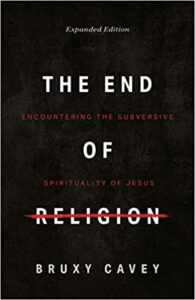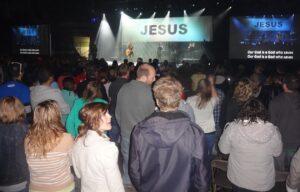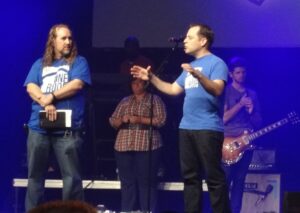THE MEETING HOUSE TIMELINE
1780: Jacob Engle developed a confessional statement that would be foundational in what would later be called the Brethren in Christ (BIC) denomination in the U.S.
1986: Upper Oaks Community Church began as a BIC church plant in Oakville, Ontario, led by pastor Craig Sider.
1991: Bruxy Cavey took a position as pastor at Heritage Baptist Church in Ancaster, Ontario.
1995: Cavey’s divorce followed by his resignation from HBC.
1996: Bruxy Cavey became the new pastor at Upper Oaks Community Church, Oakville, Ontario.
2000: Upper Oaks changed its name to The Meeting House.
2001: The first regional campus began in Ancaster, Ontario at the Silver City Theatre; total attendance Sundays tops 1000.
2007: The large warehouse on Bristol Circle in Oakville was purchased and renovated as the central location of TMH.
2007: Cavey’s first book, The End of Religion, was released.
2011: The twenty-fifth anniversary event was held in Powerade Centre in Brampton, Ontario.
2013: The Canadian office of BIC became independent of its American parent denomination; BIC Canada soon became “Be in Christ” Canada.
2017: Herald Press released Cavey’s second book, Reunion: The Good News of Jesus for Seekers, Saints, and Sinners.
2019: Danielle Strickland became TMH co-pastor.
2021 (December): Cavey was removed from his role in the church due to allegations of sexual impropriety.
2022 (March 2): Cavey resigned from his position at TMH, with compensation.
2022 (June 6): Cavey was formally charged with sexual assault by Hamilton Police.
2022 (June 8): TMH overseers released news that they had received thirty-eight reports of sexual misconduct or abuse.
2023 (March): Victim advocate Melodie Bissell resigned from her position citing a leadership change in the church that was less supportive of victims.
2023 (December 22): Cavey was charged with two new counts of sexual assault by Hamilton police unrelated to the first charge.
2023 (December 28): Criminal trial for Cavey was set to begin in Ontario court in February 2024.
FOUNDER/GROUP HISTORY
The Meeting House began as a church plant of The Brethren in Christ denomination in Oakville, Ontario, a suburb of Toronto. This small denomination began as an off-shoot of Mennonite groups in Pennsylvania in the 1770s, mostly around the insistence on triune immersion as the Scriptural mandate for baptism. Jacob Engle developed a confessional statement in 1780 for these “River Brethren” (in Canada “Tunkers”) that became key for what would later be called the Brethren in Christ denomination in the U.S. (Sider 1999). The BIC was a very small denomination in Canada, with a total of only about 3,000 members nationwide until about 1997, when numbers began to climb.
While Craig Sider is the original founder of what came to be called The Meeting House (TMH) in 1986, it was only a fledgling church plant of the BIC Canada under Sider’s leadership located in Oakville, Ontario, Canada, a suburb of Toronto. The Meeting House exploded in size and influence after Bruxy Cavey assumed leadership in 1997.

Bruxy Cavey [Timothy Bruce Cavey] was born in 1965 in Montreal, Quebec, [Image at right] and had three significantly older sisters. He also had an older brother who died at age twelve from cancer, two years before Cavey was even born. His parents moved to Scarborough, a suburb of Toronto, and there Cavey attended the large and well-known People’s Church school (a missions-focused Pentecostal church with its own k-12 school) and on Sundays the family attended the large Agincourt Pentecostal Church (Schuurman 2019).
Cavey was part of a drama troupe that organized youth rallies and evangelistic outreach. His public speaking skills, along with his long hair and provocative style gave him a name in local evangelical circles. He achieved a B.A. in psychology from York University in the mid 1980s and did some promotional work for World Vision with young adults. After he finished a master’s degree in theological studies at Tyndale Seminary in Toronto, he became the pastor of Heritage Baptist Church in Ancaster, Ontario (Fellowship Baptist) in 1991. The church grew exponentially, soon shifting over to the campus auditorium at Redeemer University Sunday mornings. His reputation as a preacher was growing in the Greater Toronto Area (Schuurman 2019).
After just a few years, when Cavey and his first wife divorced, Cavey resigned from the church feeling disgraced (1996). He was unemployed for a number of months before re-engaging with the Brethren in Christ (now Be in Christ) bishop in the Toronto region, who invited him to succeed Craig Sider at Upper Oaks Community Church, a small church plant in Oakville. He became pastor in 1997, and within a few years the church grew to thousands, plateauing at about 5,000 attendees and twenty regional sites by 2020. Cavey’s theology shifted to Anabaptist with this new position.

Cavey’s on-stage persona is part teacher, part talk show host, and part stand-up comedian. [Image at right] His T-shirt and jeans attire, his provocative and theologically informed presentations, and his facility in exegeting Biblical texts, attracted many who were discontented with or wounded by their experience in other churches. Because they rented movie theatres as their regional sites, they offered an atmosphere that was non-threatening to inquirers and appropriate given his constant references to popular culture. The central location, called the Oakville Production Site, was a refurbished industrial warehouse turned into a theatre-style auditorium that could seat up to 1600 people. Cavey would hold three services on Sunday mornings in Oakville while other regional sites played recordings of the sermon (“teaching”) from the previous week (Schuurman 2019).
In its first thirty-five years, TMH circulated through about 30,000 attendees. Turnover was high while the total numbers held fairly steady around 5,000 after 2010 until 2022. Cavey was a popular speaker at evangelical conferences and the web presence of the church was extensive. TMH was one of the largest Anabaptist churches in North America at its peak, and Cavey was claimed as Anabaptist theology’s celebrity champion, speaking on pacifism and other Anabaptist essentials that were growing in popularity in the West (Murray 2010). A wider network of churches with Anabaptist-like commitments formed after 2017 called The Jesus Collective, which Cavey was instrumental in developing and leading; it claims member churches from around the world.
DOCTRINES/BELIEFS
The core beliefs of TMH are on one level similar to those of Brethren in Christ (BIC) churches (now Be In Christ Canada). Palmer Becker summarizes the Anabaptist tradition in Anabaptist Essentials, explaining that “the centre of our faith is Jesus, the centre of our life is community, and the centre of our work is reconciliation” (2017:20). The BIC website explains that their church is influenced by four traditions, in this way: Anabaptism would be the trunk with Pietism, Wesleyanism, and Evangelicalism being the branches. Key to its Anabaptism are such practises as pacifism, simplicity, adult baptism, a Jesus-centred Biblical hermeneutic, strong communitarian values, and discipleship of believers. Their notion of the kingdom of God overlaps closely with their theology of church and often is understood in contrast to the state. Notions of “separation from the world” have historically been important.
The Meeting House stands in this tradition and upholds these values, but its prominence in Canadian evangelicalism was due more to its “irreligious” message , shaped by Bruxy Cavey. This was its religious brand and front-stage identity. Cavey’s bestselling book The End of Religion (Navigators 1997) [Image at right] was a manifesto of sorts for the church, and the marketing, sermons, and ethos of the church was directed towards developing a “spiritual but not religious” atmosphere that distinguished the church from stiff, conservative, middle-class evangelical culture. This rebellion against traditional church culture was the hallmark of the church, couched in nostalgia for the peace and love themes of the 1960s and the imagined simplicity of Old Mennonite communities. It was fresh and ironic, and attracted many disaffected members from other conservative traditions and a few who had no significant Christian history or memory. This hip, negative identity is described in detail in Schuurman (2019) as central to Cavey and the church’s charisma. Schuurman argues that TMH offered a legitimate cultural identity to conservative Christians stigmatized by the dominant secular culture in Canada, and Cavey’s charisma was the rallying point for this counter-cultural vision.
, shaped by Bruxy Cavey. This was its religious brand and front-stage identity. Cavey’s bestselling book The End of Religion (Navigators 1997) [Image at right] was a manifesto of sorts for the church, and the marketing, sermons, and ethos of the church was directed towards developing a “spiritual but not religious” atmosphere that distinguished the church from stiff, conservative, middle-class evangelical culture. This rebellion against traditional church culture was the hallmark of the church, couched in nostalgia for the peace and love themes of the 1960s and the imagined simplicity of Old Mennonite communities. It was fresh and ironic, and attracted many disaffected members from other conservative traditions and a few who had no significant Christian history or memory. This hip, negative identity is described in detail in Schuurman (2019) as central to Cavey and the church’s charisma. Schuurman argues that TMH offered a legitimate cultural identity to conservative Christians stigmatized by the dominant secular culture in Canada, and Cavey’s charisma was the rallying point for this counter-cultural vision.
Hipster Cavey’s irreverent late-night talk show persona was a direct contrast to the stereotyped serious, politically entangled, three-piece suit evangelical preacher that, for example, led such groups as the Moral Majority. His theological commitment to pacifism, along with his distance from any politics in his sermons or life, seemed refreshing to many Canadians used to right-wing evangelical news from the U.S. The Emerging Church Movement, coalesced around such figures as Brian McLaren, contains many similarities to the style and concerns of TMH, and McLaren spoke at TMH and has a blurb on Cavey’s first book (Schuurman 2019; Marti and Ganiel 2014). Both Cavey and the Emerging Church Movement share a history and affection for the earlier Jesus People Movement (Bustraan 2014). This primitivist spirit found alignment with the tenets of the Radical Reformation that inspired Anabaptism and the BIC.
RITUALS/PRACTICES
As a megachurch, the church was focused on growth called “evangelism,” and that meant a focus on electronic media and expansion (Ellingson 2007;  Thumma and Travis 2007; Elisha 2011). The labour invested in marketing, electronic media, and high-quality video production was significant, and the web-presence of the church, including its on-line sermon search engine, was impressive. [Image at right] Seating and church atmosphere was patterned after movie theatre structures and style. TMH cannot be understood apart from the megachurch movement in North America, even though Cavey insisted on defining TMH as a collective of home churches (Schuurman 2019).
Thumma and Travis 2007; Elisha 2011). The labour invested in marketing, electronic media, and high-quality video production was significant, and the web-presence of the church, including its on-line sermon search engine, was impressive. [Image at right] Seating and church atmosphere was patterned after movie theatre structures and style. TMH cannot be understood apart from the megachurch movement in North America, even though Cavey insisted on defining TMH as a collective of home churches (Schuurman 2019).
Because of this evangelistic focus, many church events were intended to be invitational to outsiders. The language and sermon topics were developed to resonate with popular culture rather than traditional church culture, so pop culture was a consistent reference point for all activities of the church. Evangelical church culture and its insider language in many senses became taboo.
TMH follows BIC practises such as adult baptism, complete with the triple immersion and Trinitarian invocation. Testimonies of conversion or rededication would usually accompany the ritual. Often this involves re-baptising those baptised as infants who came to TMH from other Christian denominations (Schuurman 2019).
In accordance with its pacifist commitments, TMH does not encourage political involvement, military, police or security vocations, or any kind of work that would involve state defence or violence. Their emphasis on simplicity curbs their participation in North American consumerism. TMH also promoted generosity in financial giving to the church and beyond (Schuurman 2019).
Communion (eucharist) was celebrated in the Home Churches as led by the elders of those small groups and very infrequently in the regional sites. In BIC tradition, the “Love Feast” was a gathering intended to spur fellowship and community, and these would be held randomly, sometimes in concert with other events like multiple baptisms (Schuurman 2019).
One characteristic ritual described in length in Schuurman (2019) is what was called “Purge Sunday.” This was typically a short speech by Cavey on a Sunday morning encouraging people to move deeper into the culture of the church, or else find another church to attend. This Purge Sunday strategy plays with the evangelical tradition of the altar call by reversing the social pressure: instead of calling people to the front stage for Jesus and church membership, Cavey asks people to leave the building for Jesus and participate in another church, if their current default would only be as a spectator at TMH (Schuurman 2020a).
ORGANIZATION/LEADERSHIP
While TMH shares some ecclesiology with its parent BIC denomination, its organization paralleled more closely the megachurch model promulgated by Willow Creek Association and similar evangelical mission organizations. The governing authority was a board called “the overseers,” which consisted of committed members from several different sites, with one person designated as the chair. Individual sites did not have separate boards or governing structures (Schuurman 2019). In Canada, most megachurches do retain their connection with a denomination (Wilkinson and Schuurman 2020). Unlike most megachurches globally, TMH has no connection to the prosperity gospel; in fact, it has more of a teaching on downward mobility focused on a cruciform theology (Schuurman 2019a).

A head office at the Oakville Production Site centralized operations, finances, ministry and vision and distributed the vision and practises to its regional sites. [Image at right] Sunday services consisted of local music teams leading singing followed by a video of the teaching, which was usually Cavey. At one point this was referred to as a franchise model, and brand consistency was emphasized, including the alignment of Sunday morning songs at all sites each week. Each regional site had Home Churches connected with it: these were small groups of attendees who met to review the Sunday teaching, share food together, and some were active in “compassion” activities (their term for local community involvement, such as volunteering at a food bank). At times, these Home Churches numbered in total from all sites nearly 200, with many having around thirty names on their group email lists. Each Home Church in turn may have had a number of “Huddles,” four or five person groups with members of the same sex that were intended for intimate conversation, confession of sin, and prayer. There were also “distance sites” around the world, small groups of people who gathered in homes to watch the Sunday teachings together on a regular basis. These international gatherings often included ex-pats who had some history attending TMH in Ontario (Schuurman 2019).
This structure of small groups and Huddles Cavey compared to John Wesley’s method, but structurally it followed general megachurch models and best practises often shared in evangelical conferences on evangelism and mission (Cavey and Carrington-Philips 2012; McConnell 2009). A common phrase heard in megachurches is “the larger we grow, the smaller we become,” a reference to the emphasis on attendees joining Home Churches (small groups). Nevertheless, the bulk of staff labour, volunteer hours, and economic investment went into the Sunday venues and the sermons they featured.

The structure of centralized leadership at TMH shifted through the decades, beginning with Cavey as Teaching Pastor and Tim Day as Executive Pastor. [Image at right] After Day left in 2015, the leadership structure shifted to a four-person model, with Cavey as the main teaching pastor and the others focused on various operational matters. Eventually popular evangelical author and speaker Danielle Strickland was included as a co-teaching pastor with Cavey. She had a Salvation Army background, but among other theological commitments, she shared with Cavey a fascination for zombie movies (Strickland 2017) and has marketed herself as “the ambassador of fun.”
All leaders were responsible to and reported to the Overseers. At times the total number of staff could be over fifty, including all paid regional site staff (like site pastors), as well as those in finance, marketing, youth ministry, curriculum development, and other operations. BIC (Canada) denominational staff used the same building and at times shared personnel. Turnover was frequent and roles and titles often changed, especially during the years of rapid expansion from 1998-2008 (Schuurman 2019).
Cavey often spoke of the model as a “team leadership” model, although the central personality and influential power lay with Cavey. He was not a command-and-control type of leader, and many overseers spoke of his gentle approach and at times reticence to weigh in on matters of governance. He was glad to delegate operational matters to others and at times even seemed disinterested in personnel issues. But when he did contribute to discussions at the board level, his words carried significant weight (Schuurman 2019).
Because all but the Oakville Production Site (the main warehouse/theatre facility with headquarter offices) was a rented venue in a movie theatre, the need for volunteers was great. Along with financial giving and attendance at a Home Church, what was once called “core members” were expected to give of their time volunteering in some capacity. Some said that for a regional site meeting in a movie theatre to thrive, it needed about 100 committed attendees to start (Schuurman 2019).
After Cavey was charged with sexual assault in 2022, the structure and culture of TMH was assessed, and the Overseers committed to a more de-centralized system. All senior leadership exited their roles, including some overseers and site pastors. Overseers planned to collapse the twenty sites into six regional sites. The budget shrunk to sixty percent of its previous level, and some significant changes were made to operations and staff (Schuurman 2022).
ISSUES/CHALLENGES
TMH struggled with many issues common to the megachurch model. Rapid growth takes a toll on community. Centralized leadership could eclipse local initiative at the regional sites. Cavey’s talent and celebrity prevented younger staff from regular opportunities to preach and develop their own skills and leadership identity. Furthermore, because the church was so large and spread out, and turnover of attendees was so high, individual persons could be lost in the crowds. Home Church offered a smaller community in which to be known, but often leaders lacked the pastoral skills or time to attend to serious pastoral issues (Schuurman 2019).
The pacifist commitment was a barrier to some attendees, and it was difficult to cultivate as a shared value. A few attendees remained active in police work and political parties, despite the teaching against government work, which was said by Cavey to involve the person in the state’s monopoly on violence. Paying one’s taxes was still encouraged (Schuurman 2019).
As a mostly white middle-class church in one of the world’s most diverse cities, TMH needed to be deliberate about diversifying both its attendees and leadership, which became more of a concern after 2012. Female pastoral leaders were a small proportion of the total pastoral staff, although that started to change around 2014 as well, culminating in Danielle Strickland’s hire in 2019 (Schuurman 2019).
The most devastating event in the history of this megachurch was the accusations that were made against Bruxy Cavey pertaining to sexual abuse that arose in 2021. An independent investigation concluded in March 2022 that he was guilty of “an abuse of power and authority by a member of the clergy that amounted to sexual harassment” but this was later corrected in June 2022 by a subsequent investigation and re-labeled as “sexual abuse by a church leader” (Bocknek 2022b; Schuurman 2022a; Shellnutt 2022). On June 6, 2022, Cavey was formally charged with sexual assault by Hamilton Police, and subsequent court appearances were put under a publication ban. He was released on conditions.
The overseers responded to these revelations with regular Town Hall meetings and inviting all those who were abused by any pastoral staff to connect with an appointed victim advocate. Free counseling was offered to anyone who felt they might need some support. By June 2022, thirty-eight reports of abuse were received, directed towards four former pastors, including Tim Day, who had left in 2015 to work as director of Waybase ministries. He resigned from that role when the announcement was made (Schuurman 2022; Shellnut 2022).
By September 2022 Cavey had four charges against him, two considered sexual abuse, one deemed sexual misconduct, and one involving a minor (Bocknek 2022b). Attendance began declining since the news was made public, and while some attendees were defensive of Cavey at first, many expressed deep disappointment and anger towards Cavey in social media (Schuurman 2022b).
Reports to the appointed church advocate from victims have reveal that TMH system functioned to protect itself and its leadership. Overseers shared in a Town Hall Meeting on June 7 that those who tried to address the issues “felt shut down.” There was “a skew to prioritizing the care and wellbeing of offenders over victims,” said the co-chair of the overseers. “There are multiple stories of victims who felt shamed and rejected by the church while the offender was supported through so-called restoration” (Gilmore 2022).
After the allegations came forward, mainstream Canadian and American media became deeply interested in TMH, and articles appeared in Religion News, The Washington Post, Christianity Today, The Toronto Star, Broadview Magazine, and Christian Courier in 2022.
Then on December 22, 2023 Cavey was charged with two new counts of sexual assault by Hamilton police unrelated to the first charge. His trial was already set to begin in February 2024 and Cavey’s lawyer Megan Savard says they will plead “not guilty.”
IMAGES
Image #1: Bruxy Cavey.
Image #2: Cavey speaking at the “One Roof” event in October 2012.
Image #3: Front cover of The End of Religion: Engaging the Subversive.
Image #4: The “One Roof” event in October 2012, where all regional sites gathered for a joint worship service and a dance party in the Powerade Centre, Brampton Ontario.
Image #5: The converted warehouse known as The Oakville Production Site, Oakville.
Image #6: Cavey and Tim Day introducing a new strategic plan.
REFERENCES
Beaty, Katelyn. 2022. Celebrities for Jesus: How Personas, Platforms, and Profits are Hurting the Church. Ada, MI: Brazos Press.
Becker, Palmer. 2017. Anabaptist Essentials: Ten Signs of a Unique Christian Faith. Harrisonburg, VA: Menno Media.
Bocknek, Morgan. 2022a. “He Was a Celebrity Pastor at One of Canada’s Biggest Megachurches. Inside the Sexual Abuse Allegations That Brought Down Bruxy Cavey.” Toronto Star, August 13.
Bocknek, Morgan. 2022b. “Her Allegations Brought Down Megachurch Pastor Bruxy Cavey. Then the Anonymous Trolls Came for Her.” Toronto Star, September 23.
Bustraan, Richard. 2014. The Jesus People Movement: A Story of Spiritual Revolution Among the Hippies. Eugene, OR: Pickwick.
Cavey, Bruxy. 1997. The End of Religion: Engaging the Subversive. Colorado Springs, CO: Navigators.
Cavey, Bruxy and Wendy Carrington-Philips. 2012. “ Pp. 151-77 in The Church, Then and Now, edited Stanley Porter and Cynthia Long Westfall. Eugene, OR: Pickwick.
Ellingson, Stephen. 2007. Megachurch and the Mainline: Remaking Religious Tradition in the Twenty-first Century. Chicago: University of Chicago Press.
Elisha, Omri. 2011. Moral Ambition: Mobilization and Social Outreach in Evangelical Megachurches. Berkeley: University of California Press.
Gilmore, Meagan. 2022. “At Canadian Megachurch, One Abuse Investigation Spurs Another and Another.” Christianity Today, June 27.
McConnell, Scott. 2009. Multi-Site Churches: Guidance for the Movement’s Next Generation. Nashville, TN: B&H Publishing.
Mulder, Mark and Gerardo Marti. 2020. The Glass Church: Robert H. Schuller, the Crystal Cathedral, and the Strain of Megachurch Ministry. Rutgers: Rutgers University Press.
Murray, Stuart. 2010. The Naked Anabaptist: The Bare Essentials of a Radical Faith. Harrisonburg, VA: Herald Press.
Schuurman, Peter. 2019. The Subversive Evangelical: The Ironic Charisma of an Irreligious Megachurch. Montreal: McGill-Queens University Press.
Schuurman, Peter. 2019a. “Megachurches.” In Brill’s Encyclopedia of Global Pentecostalism Online, Edited by Michael Wilkinson, Conny Au, Jörg Haustein, and Todd M. Johnson. Accessed from https://referenceworks.brillonline.com/entries/brill-s-encyclopedia-of-global-pentecostalism/megachurches-COM_040592 on 1 October 2022.
Schuurman, Peter. 2020. “Redeeming a Spoiled Identity: Purge Sunday at the Anabaptist Megachurch.” Liturgy 35:3-10.
Schuurman, Peter. 2022a. “Ten Months of Turmoil.” Christian Courier, October 10.
Schuurman, Peter. 2022b. “The Walking Wounded: Meeting House Attendees Respond to News of Pastor Abuse.” Christian Courier, October 10.
Sider, E. Morris. 1999. Reflections on a Heritage: Defining the Brethren in Christ. Mechanicsburg, PA: Brethren in Christ Historical Society.
Shellnutt, Kate. 2022. “Ontario’s Most Influential Pastor Resigns Following Abuse Investigation.” Christianity Today, March 10.
Strickland, Danielle. 2017. The Zombie Gospel: The Walking Dead and What It Means to Be Human. Westmont, IL: Intervarsity Press.
Thumma, Scott and Dave Travis. 2007. Beyond Megachurch Myths: What We Can Learn From America’s Largest Churches. San Francisco: Jossey-Bass.
Wilkinson, Michael and Peter Schuurman. 2020. “Megachurches in Canada: Evangelical Outposts in a Secular Society.” Pp. 269-83 in Handbook on Megachurches, edited by Stephen Hunt. Leiden: Brill.
Publication Date:
2 October 2022
